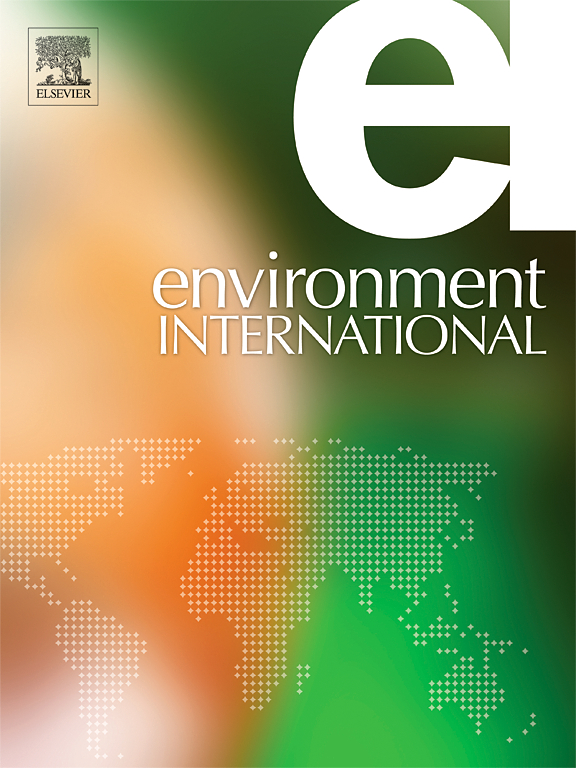基于废水的抗菌素耐药性分析在英国机场:评估潜在的机遇和挑战
IF 9.7
1区 环境科学与生态学
Q1 ENVIRONMENTAL SCIENCES
引用次数: 0
摘要
机场每年客运量达4000万人次,是来自不同地理来源的微生物群落汇聚、混合和分布的关键枢纽。机场和飞机产生的废水既是抗微生物药物耐药性(AMR)生物在全球传播的潜在途径,也是加强全球AMR监测的未充分利用的资源。本研究调查了从英国三个国际机场(伦敦希思罗机场、爱丁堡和布里斯托尔)的机场航站楼(n = 132)、飞机(n = 25)和连接的废水处理厂(n = 11)收集的废水样本中抗菌素耐药性基因(ARGs)的丰度和多样性。采用高通量qPCR (HT-qPCR)对76个ARGs进行定量分析,同时对一部分样本(n = 30)进行宏基因组测序分析。我们的研究结果表明,尽管飞机废水抗性组的多样性相似,但它们在组成上不同于在机场航站楼观察到的抗性组。值得注意的是,从亚洲和非洲起飞的航班携带的独特arg数量高于从欧洲和北美起飞的航班。然而,ARG剖面的聚类显示与地理没有总体关联。爱丁堡码头和泵站的废水在组成上与连接的城市污水处理厂的废水相当,尽管需要进一步研究来确定当地人口和国际旅行者的相对贡献。这项研究首次对多个国际机场的飞机和航站楼废水中的AMR进行了全面调查。我们的研究结果强调飞机废水是AMR跨境传播的潜在途径,也是全球AMR监测的宝贵工具。然而,研究结果还强调了机场环境中抗菌素耐药性监测标准化方法的局限性和必要性,以有效减轻抗菌素耐药性的全球传播并加强公共卫生监测战略。本文章由计算机程序翻译,如有差异,请以英文原文为准。


Wastewater-based analysis of antimicrobial resistance at UK airports: Evaluating the potential opportunities and challenges
With 40 million annual passenger flights, airports are key hubs for microbial communities from diverse geographic origins to converge, mix, and distribute. Wastewater derived from airports and aircraft represent both a potential route for the global dispersion of antimicrobial resistant (AMR) organisms and an under-utilised resource for strengthening global AMR surveillance. This study investigates the abundance and diversity of antimicrobial resistance genes (ARGs) in wastewater samples collected from airport terminals (n = 132), aircraft (n = 25), and a connected wastewater treatment plant (n = 11) at three international airports in the UK (London Heathrow, Edinburgh and Bristol). A total of 76 ARGs were quantified using high throughput qPCR (HT-qPCR) while a subset of samples (n = 30) was further analysed by metagenomic sequencing. Our findings reveal that aircraft wastewater resistomes were compositionally distinct from those observed at airport terminals, despite their similar diversity. Notably, flights originating from Asia and Africa carried a higher number of unique ARGs compared to those from Europe and North America. However, clustering of the ARG profile displayed no overall association with geography. Edinburgh terminal and pumping station wastewater had compositionally comparable resistomes to that of the connected urban wastewater treatment plant, though further research is needed to determine the relative contributions of the local population and international travellers. This study provides the first comprehensive investigation of AMR in wastewater from both aircraft and terminals across multiple international airports. Our results highlight aircraft wastewater as a potential route for cross-border AMR transmission and a valuable tool for global AMR surveillance. However, the findings also underscore the limitations and need for standardised approaches for AMR monitoring in airport environments, to effectively mitigate the global spread of AMR and enhance public health surveillance strategies.
求助全文
通过发布文献求助,成功后即可免费获取论文全文。
去求助
来源期刊

Environment International
环境科学-环境科学
CiteScore
21.90
自引率
3.40%
发文量
734
审稿时长
2.8 months
期刊介绍:
Environmental Health publishes manuscripts focusing on critical aspects of environmental and occupational medicine, including studies in toxicology and epidemiology, to illuminate the human health implications of exposure to environmental hazards. The journal adopts an open-access model and practices open peer review.
It caters to scientists and practitioners across all environmental science domains, directly or indirectly impacting human health and well-being. With a commitment to enhancing the prevention of environmentally-related health risks, Environmental Health serves as a public health journal for the community and scientists engaged in matters of public health significance concerning the environment.
 求助内容:
求助内容: 应助结果提醒方式:
应助结果提醒方式:


